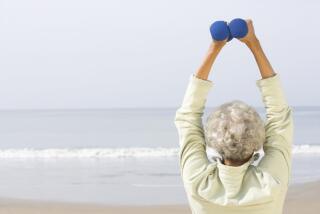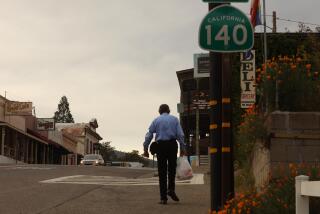Making Homes Safe, Comfortable for Elderly
- Share via
The elderly would prefer to age in one place, studies show, but they need different features in their homes to live there safely and comfortably, according to geriatric experts and building designers.
“People tend to change their behavior when they could change their environment [instead],” said USC gerontology professor John Pynoos. “They give up sewing because they think they can’t see. But it’s really the lighting. They give up cooking because the broiler is too low to reach. It has a depressing effect to give up doing things.
“We build our houses for when we’re young,” Pynoos said. “Peter Pan houses, for people who never age.”
The answer is to fit the house to its occupants.
As Pasadena building designer Mary Coolman pointed out: “These are not people who need to be in a hospital. They just need a little help.”
Here are some tips from the experts on how to make a home, condo or apartment safer and more comfortable for an elderly resident:
* Install rocker switches in place of wall switches, which are painfully difficult for arthritic hands to use. Rocker switches can even be activated by elbows.
* Consider adding extra rocker light switches at both ends of hallways, near the bed and outside the bathroom door to reduce the time a person needs to be in the dark.
* Install front door closures that stay locked when closed. This way, a visitor or health care worker won’t accidentally leave the door unlocked and put the elderly resident at risk. Also, move the mailbox to the front door or install a mail slot in the door.
* Make sure steps, where most home accidents occur, are safe. Put strips on slippery steps. Make sure carpeting is tight. Color the edges of the first and last step to compensate for failing eyesight. Put handrails on both sides of stairwells for optimum safety.
If there’s only one step, replace it with a slight ramp. “Just one step is a tripper,” designer Coolman said.
* Replace dual-control faucets with single levers for those with limited hand flexibility. Large wooden levers can also be installed over smaller knobs. In the shower, preset controls can prevent scalding or freezing.
* Check the whole house for loose extension and phone cords that can cause tripping.
* Remove small throw rugs, which play havoc with wheelchairs or walkers.
* Remove high thresholds in doorways, a simple task.
* Consider raising the height of the bathroom vanity; bending over and leaning on a low counter for brushing teeth or washing up can cause back pain.
* Explore alternatives to adding a bathroom for wheelchair access. “It’s almost always at least $10,000 to add a bathroom,” said Long Beach remodeling estimator Dottie Back. “People are shocked.”
In many cases, the plumbing on the sink can be reversed and the sink installed in the bedroom, hotel-style, so that a person in a wheelchair can wash up or get a drink of water without negotiating a doorway.
Also, a bathtub can be taken out and a large shower stall without a threshold can be set up. An added tiled bench helps, especially if the controls and a hand-held shower head are within reach.
* In the kitchen, incorporate pull-out shelves under the counter to make access easier. An inexpensive alternative is to put items in cardboard or plastic boxes that can be pulled out.
* When installing life-saving smoke detectors, have an electrician hard-wire them together so that if one goes off in the kitchen, for example, the detectors in the bedroom, living room and elsewhere will also sound alarms. Also, consider installing overhead sprinklers in the kitchen, where a forgotten pan may catch fire.
* Throughout the house, make sure lighting is extra bright to compensate for failing eyesight. In one house, Pasadena building contractor Steve Knickelbein installed ceiling fixtures with two light bulbs so that if one burns out, the elderly resident won’t be left in the dark.
* Motion lights outside give everyone a sense of safety.
* You can’t have too many night lights in halls and rooms.
However, lighting should be diffused and not cause blinding spots of bright glare. Incandescent light is better than fluorescent; the flickering from fluorescent lights has been shown to disorient and irritate elderly people.
“The vast majority of older people want to stay in their own homes,” said USC architecture professor Victor Regnier, an expert in housing for the elderly. “They don’t want to live with their kids. They don’t see that as a positive situation.”
“Independence is very important as we age,” said American Assn. of Retired Persons spokesman Tom Otwell. “Our studies show that older folks would rather age in place if they can, to stay in familiar surroundings.”
And according to Pynoos, such safety features as grab bars in bathtubs are important for all of us.
Who hasn’t slipped while in the shower? he asked. “The pope slipped and he broke his hip. George Burns slipped and he never really recovered,” Pynoos said. “So if the guy who is close to God did it and the guy who played God did it, the rest of us are even more at risk.”
*
For more tips on altering houses for the elderly, the AARP offers two free 40-page booklets: “The Perfect Fit: Creative Ideas for a Safe & Livable Home” and “The Do-Able Renewable Home.” To order, call (800) 424-3410.


